Benjamin Garland
Daily Stormer
March 21, 2017
Simone de Beauvior
Part 1, Part 2, Part 3, Part 4, Part 5, Part 6, Part 8, Part 9
“As activists, professionals, artists, and intellectuals, Jewish feminists have shaped every aspect of American life.” – Jewish Women’s Archive1
The foundational text of what became known as “second-wave feminism” was The Second Sex, which was written by the French woman Simone de Beauvior in 1948, and published in English in 1953 (the “first wave” of feminism had dissipated after the passage of the 19th Amendment, which gave women the right to vote in 1920).
Beauvior was not a Jew, but one wonders how much of her ideas were influenced by her Jewish lover, Nelson Algren – the one who “advised her” to write the book, as it says in the introduction – and her other long-time lover, the abusive Marxist philosopher Jean-Paul Sartre.2
Sartre, though also not a Jew, practically worshiped them. He authored what has to be one of the most philo-Semitic tracts of all time, The Anti-Semite and the Jew.
The book takes as its premise the Freudian concept that anti-Semites are just projecting their own shortcomings onto Jews (“If the Jew did not exist, the anti-Semite would invent him”), and ends with the outrageous declaration that “not one Frenchman will be secure so long as a single Jew – in France or in the world at large – can fear for his life.”3
Sartre even dropped his previous philosophical worldview and instead found solace in messianic Judaism during the final months of his life.4
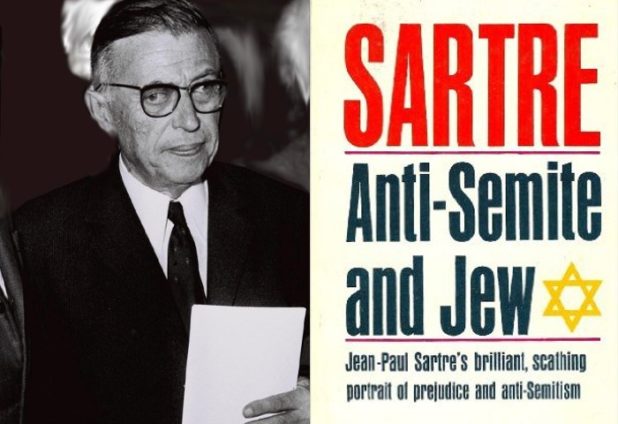
Underlying Beauvior’s The Second Sex, and therefore all of second-wave feminism, are the Jewish ideologies of Marxism and Freudianism.
Beauvior was an egalitarian absolutist – a “blank slatist” – and thus she denied human nature and gender differences in their entirety. According to her, all feminine personality traits have been imposed on women from the outside, by society, by the “patriarchy.”
“One is not born, but rather becomes, woman” she wrote, famously.5
The only reason women hold what, in Beauvior’s estimation, is an inferior role in society and history, is because men have actively held them back. In this she declared women’s solidarity with Blacks and Jews, as mutually oppressed victims of cultural and social conditioning by White heterosexual males.6
Beauvior claimed that “no ‘maternal instincts’ exist,” and that marriage is “domestic slavery.”7 The only way for a woman to “establish her existence,” she argued, is to get out of the home and get a career; children must be taken care of by the state.8
Housewives, Beauvior stated repeatedly, are “parasitic.” True equality, in her view, would only be reached when “both sexes have equal legal rights,” and “the whole of the feminine sex [enters] public industry.”9

The Second Sex betrays an inferiority complex in Beauvoir, and is written in a way that almost seems calculated to instill one into its women readers. This is a constant with all feminist philosophy – and therein lies its danger.
By denying women’s natural and sacred role of mother and caregiver, and instead professing they are “equal” to men, the feminist philosophy inevitably invokes in women envy about their historic and current inferior role in the realm of male activities. This in turn leads to feelings of frustration, anger and hatred toward men, as well as a totalitarian impulse to impose their will on society using pro-feminist laws and policies backed by the power of the state.
This feminist totalitarian impulse was readily observable in Beauvior. In a discussion with Jewish feminist Betty Friedan (who is discussed further below), which was published in the Saturday Review, Beauvior stated that she believed that “no woman should be authorized to stay at home to raise her children” – that society should actually force them to get a career instead – “because if there is such a choice, too many women will [decide to stay home].”
“In my opinion,” she goes on to say, “as long as the family and the myth of the family and the myth of maternity and the maternal instinct are not destroyed, women will still be oppressed.”10
Beauvior also argued that in order for men and women to be truly “equal,” women must be able to engage in casual sex without suffering any negative consequences. The prerequisites for this are: safety (i.e. the force of the state to compensate for physical inferiority), the removal of the social stigma placed upon women who surrender their chastity early (e.g. campaigns against “slut-shaming”), and the removal of the fear of pregnancy (i.e. birth control and abortion-on-demand).
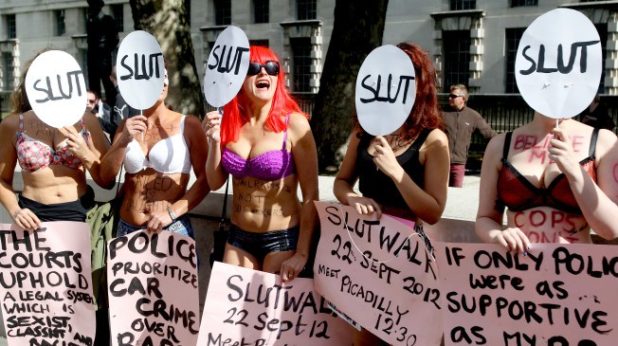
The sex-obsessed early feminist Margaret Sanger, whose surname came from a Jewish husband, campaigned for a pill that would block pregnancy for many decades, believing as far back as 1912 that it would be the only way to properly “emancipate” women.
In 1951, she commissioned the Jewish scientist Gregory Pincus to work on developing such a pill. Though this endeavor was still far from being socially acceptable to the wider public, Pincus had no reservations about how society would view him, and he had nothing to lose.
At the time, he was struggling financially and professionally, and he had been dismissed from his position at Harvard years earlier after receiving widespread condemnation in the press, which characterized him as a mad scientist straight from the pages of Brave New World for his experiments in trying to harvest rabbit eggs in test tubes.11
 Dr. Gregory Pincus
Dr. Gregory Pincus
Pincus chose as his partner in developing the pill a Catholic dissident with homosexual tendencies named John Rock. He passed over his first two choices, Abraham Stone and Alan Guttmacher, because they were also both Jews, and Pincus didn’t want to “invite criticism” against Jews.12
Pincus, Rock, and Sanger, supported financially by the wealthy widowed Protestant feminist Kathy McCormick, succeeded in developing their pill by the end of the 50s, and by the 60s it was being distributed to millions of American women.
“The Pill” was a necessary prerequisite for second-wave feminism, as well as the broader “sexual revolution,” which had been brewing under the surface of American life for some time, as it allowed women to engage in casual sex without the fear of pregnancy and/or pursue a career without having unwanted children to care for.

In 1963 Betty Friedan (née Goldstein), a closet Marxist, took the nation by storm when she published The Feminine Mystique, which quickly became a bestseller.
The main thrust of The Feminine Mystique was that being a housewife is an intolerably miserable existence. She backed up this theory almost entirely with anecdotal evidence from alleged interviews she had conducted with everyday women, and the fraudulent data of Alfred Kinsey’s Sexual Behavior in the Human Female, which claimed that a shockingly high amount of women were already, in the 1950s, having premarital and extramarital sex and abortions (see part 5 for more on Kinsey).
Friedan claimed that she had been unable to find even one single housewife out of the hundreds – or maybe even thousands – that she had interviewed, who was happy with their life. (This was a bald-faced lie, as examples of women who legitimately enjoyed being housewives were easily found in great numbers back then.13 It was not the only time that Friedan would deliberately portray a minority opinion as a majority one in order to sell it to the public, as we’ll see below.)
She quotes an anonymous doctor as allegedly saying: “You’d be surprised at the number of these happy suburban wives who simply go berserk one night, and run shrieking through the street without any clothes on.”14
Again, we must be mindful of the suggestibility of women. All humans are impressionable to some degree, with women much more so than men. By putting out ideas such as these, feminists plant seeds of doubt and suspicion in the minds of women; doubts about their own happiness and position in life, suspicion toward their own husbands, and men in general – the very ones who care for them.
Like Beauvior, Friedan argued that a housewife is a “parasite,” and that a woman needs to get a career in order to be “fulfilled.”
In the chapter “Seeking Sex,” she claimed that most housewives were sexually unsatisfied with their husbands, and thus either fantasized about, or were already having, affairs.
 Betty Friedan
Betty Friedan
Most controversially, Friedan compared the lives of American housewives to that of Nazi concentration camp inmates. She draws this parallel using the 1960 Holocaust horror-fantasy book The Informed Heart, which was written by a Jewish psychoanalyst named Bruno Bettelheim.
Bettelheim claimed that the systematic dehumanization on the part of Nazi guards gradually turned the Jewish inmates into virtual children who, along with becoming “inordinately interested in defecation and urination,” came to sympathize with their sadistic torturers to the point of eventually obediently marching to their deaths.15
In the chapter “Progressive Dehumanization: The Comfortable Concentration Camp” (which is what Friedan called the home), she wrote:
The women . . . who grow up wanting to be “just a housewife,” are in as much danger as the millions who walked to their own deaths in concentration camps . . . By adjusting to [the home], a woman stunts her intelligence to become childlike, turns away from individual identity to become an anonymous biological robot in a docile mass. She becomes less than human . . .16
All men, according to this logic, are comparable to sadistic SS guards if they have a wife who is at home raising children instead of out pursuing a career. A pretty extreme claim, to say the least.
Freidan’s black propaganda was internalized by countless women: “Her book awakened hundreds of thousands, if not millions, of women to what they had long felt but been unable to articulate, the way the mystique of suburban womanhood smothered aspirations for a more fulfilling life,” wrote Jewish author Daniel Horowitz.17
The publication of The Feminine Mystique is widely considered to be the official launch point of second-wave feminism, and Friedan became its de facto leader and spokeswoman.
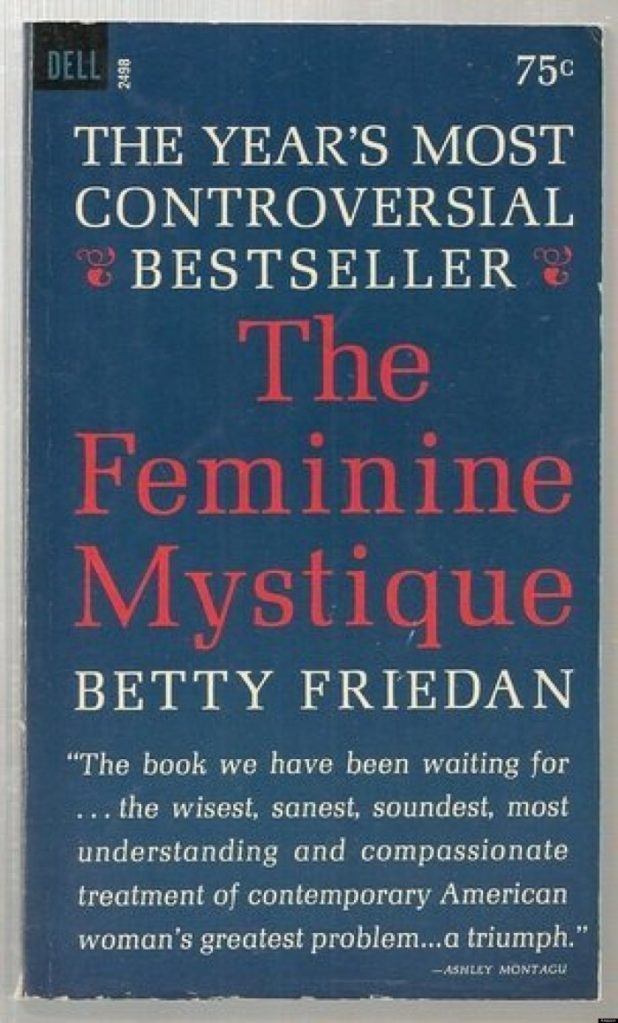
In 1966, Friedan became the first president of the National Organization of Women (NOW), which she had co-founded along with 48 other feminists.
In 1970, she organized a “Women’s Strike for Equality.” The idea behind this event, which took place on the 50th anniversary of the passage of the 19th amendment, was for women to go on “strike” nationwide by ceasing to cook or clean for their husbands.
She also arranged for there to be marches. Tens of thousands of women took to the streets all across America – as many as 50,000 in New York alone – calling for state sponsored 24/7 day care centers, legal abortion-on-demand, and equality in the workplace and education system.
The women carried banners with slogans such as “Don’t Iron While the Strike is Hot,” “Don’t Cook Dinner – Starve a Rat Today,” and the overtly Marxist “Women of the World Unite!” (a play on the Communist cry, derived from the Communist Manifesto, “Workers of the World Unite!”).
Of the five main speakers at the Women’s Strike for Equality, four were Jews – Betty Friedan, Bella Abzug, Gloria Steinem and Bess Myerson – and only one was a gentile – Kate Millett.18

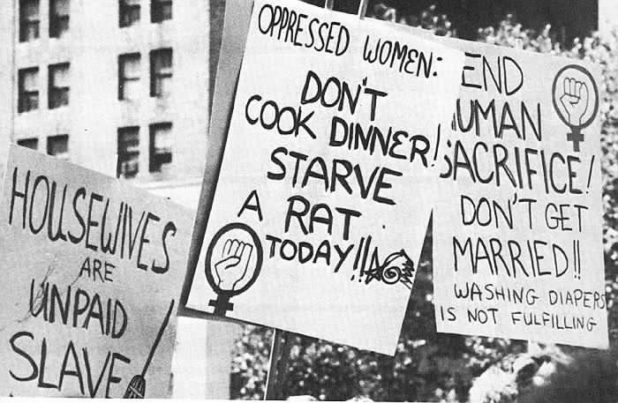
Many feminists didn’t think NOW went far enough, so they formed the New York Radical Women (NYRW), in 1967. Not content with merely marching and picketing, these women (the precursor of modern day Femen and Pussy Riot) staged outrageous and over-the-top stunts, disruptions and protests all across the nation.
When 5,000 feminists showed up in the Capitol to protest Vietnam with a “Women’s Strike for Peace,” for example, the New York Radical Women crashed it with placards reading THE DEATH OF TRADITIONAL WOMANHOOD and DON’T CRY! RESIST!19 Later they crashed the after party carrying a coffin and then symbolically buried it in a mock ritual.20
In 1969, the NYRW staged a protest at the annual Miss America pageant. Spearheaded by the hate-filled Jewess Robin Morgan, this stunt became one of the most famous and widely publicized of all feminist activities.21
The basis of their protest was the idea that Miss America “objectifies” women – “The Degrading Mindless-Boob-Girlie Symbol,” as Morgan wrote in the protest’s official pamphlet. There they handed out fliers, held up placards, mockingly crowned a sheep, and threw feminine beauty products such as make-up, eyeliner and high heel shoes into a “Freedom Trash Can.”
 The Miss America protest is where the term “bra-burners” originated, though it is inaccurate as the feminists weren’t permitted to burn anything as they had originally planned.
The Miss America protest is where the term “bra-burners” originated, though it is inaccurate as the feminists weren’t permitted to burn anything as they had originally planned.
The NYRW splintered in 1969. Some of them, such as Morgan, went on to form the group WITCH, and others went on to form the Redstockings.
WITCH, which stood for the Women’s International Terrorist Conspiracy from Hell, protested a Bridal Fair at the Madison Square Garden. Dressed in all black, they taunted the brides by singing “here comes the slaves/off to their graves,” and then released white mice into the stadium.
The other splinter group, the Redstockings, was founded by two Jewesses, Shulamith Firestone (born Shulamith Bath Shmuel Ben Ari Feuerstein) and Ellen Willis. Their Manifesto read, in part:
Women are an oppressed class. Our oppression is total, affecting every facet of our lives. We are exploited as sex objects, breeders, domestic servants, and cheap labor. We are considered inferior beings, whose only purpose is to enhance men’s lives. Our humanity is denied. Our prescribed behavior is enforced by the threat of physical violence
“All men have oppressed women,” they concluded, categorically.22
Later in that same year, 1969, the volatile Firestone split from the Redstockings and co-founded the New York Radical Feminists (NYRF) with Anne Koedt, author of the influential screed “The Myth of the Vaginal Orgasm.” With the NYRF they staged many meaningful and thoughtful protests, such as the one against the “sex-role stereotyping of Christmas toys.”23
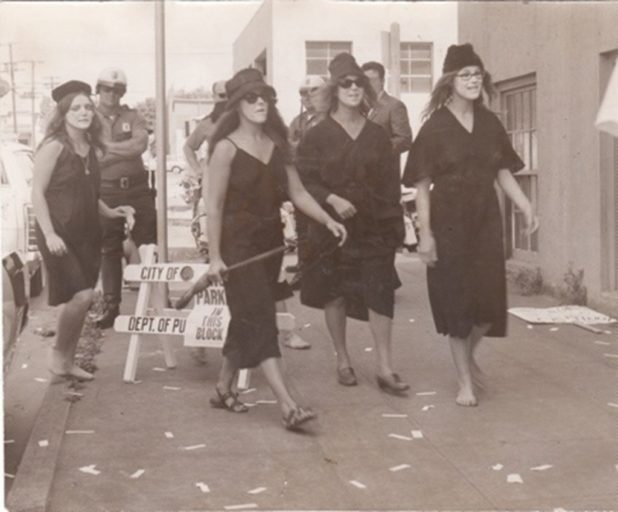 The Women’s International Terrorist Conspiracy from Hell (WITCH)
The Women’s International Terrorist Conspiracy from Hell (WITCH)
In 1970, Firestone published her book The Dialectic of Sex: The Case for Feminist Revolution, which is considered one of the classic and foundational texts of radical feminism.
The book, which would go on to be an international bestseller, is an unholy mix of Marx, Freud, Marcuse (see part 5), Reich (see part 6), and Beauvior (whom it is dedicated to). It reads like the mad ravings of a supervillain in a bad science fiction novel, revealing its diabolical plan for a dystopian future.
Whereas in traditional Marxist theory inequality stems from economic class division – the exploitation of the worker by the capitalist – Firestone argued that what inequality truly stems from, is sex class division.
Sex class division, Firestone acknowledged, is born from biological realities: most of women’s energy has always had to go toward rearing children, making them dependent on males for survival.
And of course only women have the responsibility of getting pregnant and birthing children, which, Firestone asserted, is “barbaric” – like “shitting a pumpkin.”24
Now that (male invented) technology was reaching a level where women could theoretically be freed from these biologic and reproductive inequalities – “Humanity has begun to outgrow nature” – Firestone was proposing a revolution after which artificial forms of reproduction would be normalized: “[C]hildren would be born to both sexes equally, or independently of either, however one chooses to look at it.”
After the revolution, “the tyranny of the biological family would be broken,” and humankind would become entirely androgynous: “[T]he end goal of feminist revolution must be . . . not just the elimination of male privilege but of the sex distinction itself: genital differences between human beings would no longer matter culturally.”
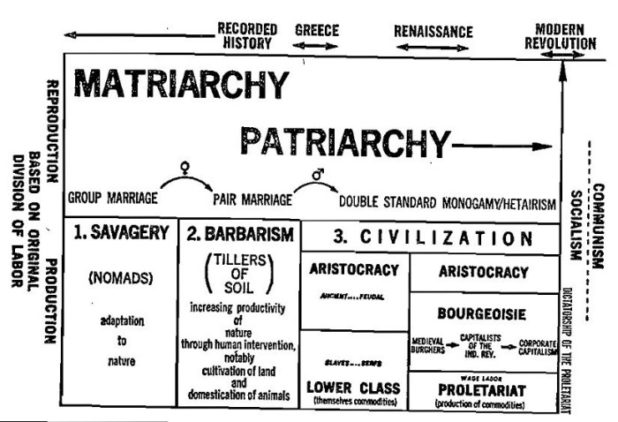 As we see in this arbitrary chart in The Dialectic of Sex, patriarchy is alleged to have begun with “pair marriage.” Therefore, reaching “equality” (i.e. communism), requires the abolition of marriage – the destruction of the family.
As we see in this arbitrary chart in The Dialectic of Sex, patriarchy is alleged to have begun with “pair marriage.” Therefore, reaching “equality” (i.e. communism), requires the abolition of marriage – the destruction of the family.
Cartoonishly, Firestone proposed that women would carry out this (presumably violent) revolution all by themselves (men, she conceded, would have no motive to assist them and thus give up their dominant role in society):
To assure the elimination of sexual classes requires the revolt of the underclass (women) and the seizure of control of reproduction: not only the full restoration to women of ownership of their own bodies, but also their (temporary) seizure of control of human fertility – the new population biology as well as all the social institutions of child-bearing and child-rearing.25
Could you imagine women plotting a “revolt” and physically “seizing” control of anything from men? How were Shulamith and her acolytes supposed to pull this off? This is never explained, nor is it remotely plausible. It’s just abstract, maniacal ramblings.
The Dialectic of Sex – which, again, is considered a classic and foundational text of second-wave feminism – should be all the proof needed that Firestone was fit for a straight-jacket, but just to be sure: it’s a matter of public record that shortly after it was published she descended into full-blown paranoid schizophrenia.
In 2012, Firestone died in obscurity in her apartment while receiving government assistance. Her rotting corpse laid there for about a week, until the neighbors finally complained about the odor to the building’s superintendent.26
She is still considered a feminist icon, nonetheless.
 Shulamith Firestone
Shulamith Firestone
Firestone’s writings, while being some of the more radical, were in many ways perfectly in line with mainline feminist thinking. One of their mantras has always been the Margaret Sanger-inspired “woman should have control over their own bodies.”
In other words, it isn’t fair that women should have to bear children and not men, so this inequality – this burden – must somehow be overcome.
One of the largest feminist victories in this regard was the legalization of abortion, which they had agitated for from the very beginning.
Betty Friedan was one of the founders, along with two other Jews, Bernard Nathanson and Lawrence Lader, of the National Association for the Repeal of Abortion Laws (NARAL), which was the foremost organization that pushed for abortion in the late 60s – early 70s.
With NARAL these Jews, evidently well-versed in human psychology, purposely used deceit to achieve their nefarious aims, as was revealed by Nathanson years later.
“Lader and I were perfect for each other,” he told conservative journalist David Kupelian, in a 2005 interview. “We sat down and plotted out the organization now known as NARAL. With Betty Friedan, we set up this organization and began working on the strategy.”
“We persuaded the media that the cause of permissive abortion was a liberal, enlightened, sophisticated one,” he continued.
Knowing that if a true poll were taken, we would be soundly defeated, we simply fabricated the results of fictional polls. We announced to the media that we had taken polls and that 60 percent of Americans were in favor of permissive abortion. This is the tactic of the self-fulfilling lie. Few people care to be in the minority. We aroused enough sympathy to sell our program of permissive abortion by fabricating the number of illegal abortions done annually in the U.S. The actual figure was approaching 100,000, but the figure we gave to the media repeatedly was 1 million.
Repeating the big lie often enough convinces the public. The number of women dying from illegal abortions was around 200-250 annually. The figure we constantly fed to the media was 10,000. These false figures took root in the consciousness of Americans, convincing many that we needed to crack the abortion law.
Another myth we fed to the public through the media was that legalizing abortion would only mean that the abortions taking place illegally would then be done legally. In fact, of course, abortion is now being used as a primary method of birth control in the U.S. and the annual number of abortions has increased by 1,500 percent since legalization.27

The Jewish feminist Heather Booth organized the Abortion Counseling Service of Women’s Liberation, better known by its codename, “Jane,” in 1968. They performed illegal underground abortions for thousands of women in two Chicago apartments, until the 1973 Roe v. Wade decision legalized it nationwide.
Jane, or the “Jane Collective,” was the “go-to” place for illegal abortions. They were only raided once. Seven abortionists were arrested, but the charges were dropped after Roe.
On the Jewish Women’s Archive website, Booth claims that her motivation for performing illegal abortions was Tikkun Olam, which translates to English as “repairing the world.”28
In practice, it would be more apt to look at Tikkun Olam as Orwellian-Yiddish code for “destroying the world.”
Just about every destructive policy the Jews push is excused by this Tikkun Olam, whether it be opening the borders for mass immigration, LGBT rights, forced integration, or, as in this case, murdering unborn babies in order to “liberate” women from having to take responsibility for their actions. Even outright Communism can fall under its banner.

Heather Booth claims she was “repairing the world” by illegally murdering unborn babies.
Beginning in the early 70s, the Jewess Gloria Steinem became the public face of feminism. This was due, largely, to her striking good looks, which is an uncommon feature among Jewesses in general, and among feminists in particular.
Steinem had first garnered recognition in 1963, after she posed as a Playboy Bunny for an investigative journalism piece for Show magazine, “A Bunny’s Tale.” In 1968, she became radicalized by attending a Redstockings meeting.
In 1972, she founded her own magazine, Ms., and put in its inaugural issue a list of 53 prominent women who were proudly “coming out” to say they had had abortions. Within 5 years, Ms. magazine had a circulation of 500,000.29

Gloria Steinem
Susan Brownmiller, another very prominent Jewish feminist, wrote in her memoir, In Our Time: “Saying ‘I’ve had three illegal abortions’ aloud, was my feminist baptism, my swift immersion in the power of sisterhood.”30 Such is the disturbing mindset of a feminist.
Brownmiller’s main claim to fame was her 1975 book on rape, Against Our Will, in which she wrote that rape is “nothing more or less than a conscious process of intimidation by which all men keep all women in a state of fear.”31
Along with legalized abortion-on-demand and other insolent feminist demands, “gender equality” to them meant that women must be allowed to have sex with as many people as they want without facing any consequences. As such, the feminists were 100% in favor of the sexual revolution from day one. Behaving like a raging slut was quite literally, in their minds, an act of “liberation.”
In 1973, the Jewish feminist Erica Jong wrote the book Fear of Flying, which has sold an astonishing 27 million copies worldwide. In Fear of Flying, Jong encourages women to cheat on their husbands. She tells them that sex with their husbands is inevitably boring and so they should be on the search for real excitement in no-strings-attached sex with complete strangers. The “zipless fuck,” she calls it.
The book includes such flowery language as “you longed to be annihilated by love, to be swept off your feet, to be filled up by a giant prick spouting sperm, soapsuds, silks and satins, and of course, money.”
Jong goes on at length in the book about her fascination with toilets and feces.32 She just couldn’t get toilets off of her mind, she explains. In fact, she did so much “thinking about toilets” while in Europe, that she once wrote out a “History of the World Through Toilets,” which she kindly shares with the reader, in all its disgusting detail.33
Erica Jong sold a book which encourages women to cheat on their husbands to 27 million women.
This bizarre fascination with feces is a characteristic that is frighteningly common among Jews. It can find no more prominent an example than yet another Jewish feminist leader, the obese lesbian Andrea Dworkin.
In her writings, Dworkin psychoanalyzed sexual acts in the most filthy and fecal-centric ways one could ever imagine, of which the following is just a small sample:
In other words . . . the vagina, is dirty like the rectum. The penis evokes the turd in the rectum because the man has the experience of touching a membrane just like the rectal wall. The relationship of the penis to the actual turd is evocative and symbolic, distant . . . For humans, the descent into the excremental is a descent into sadism and death. For women, being excremental is the dimension of inferiority that legitimates and makes appropriate sadistic sexual acts that pass as simple sex, a cruelty in sex, the brutal domination through sexual subjugation of a worthless, essentially scatological thing.34
Dworkin, who, like Firestone before her, called for the end of the “incest taboo” through “destruction of the nuclear family,” was not a fringe figure in the feminist movement, by any means, despite her unbelievably grotesque and hateful rhetoric.35 Rather, she was a broadly recognized leader and theorist.
What these mentally insane Jewish feminists have pushed on our women is absolutely shocking and breathtaking. Studying the topic at length is surreal. As the above passage indicates, there appears to be no end to the depths of their depravity.
 Andrea Dworkin
Andrea Dworkin
In conclusion, I will let Dworkin herself spell out the true aims of the feminist movement, so as to avoid any confusion.
In her 1974 book Women-Hating – again, a classic and foundational feminist text, not an obscure or fringe one – the Jewess Dworkin wrote:
We want to destroy sexism, that is, polar role definitions of male and female, man and woman. We want to destroy patriarchal power at its source, the family; in its most hideous form, the nation-state. We want to destroy the structure of culture as we know it, its art, its churches, its laws: all of the images, institutions, and structural mental sets which define women as hot wet fuck tubes, hot slits.”36
Just to reiterate, in case you didn’t catch that: feminists want to destroy gender roles, the family, the nation, culture, art, religion, law, all institutions.
In short, they want to destroy all of Western civilization (which is, indeed, synonymous with patriarchy). And they’ve gone a long way toward doing just that.
Still going strong, feminism is now in its so-called “third-wave,” with radical Jews still making up a disproportionate amount of its leadership and theorists.
Beginning in the early 1960s, when they first got going, the feminists have scored victory after victory in the legal system – the detrimental effects of which would take many volumes to even begin discussing.
Feminism has proven itself to be quite a formidable existential threat. If the damage that it has wrought is not reversed in its entirety – with a very firm hand – our civilization will soon be gone, forever.
In part 8, we will look at how Jews have been using film as a weapon of moral subversion, and then we will conclude our series with part 9, where we look at the Jewish control of hardcore pornography.
If you enjoy this series, please consider supporting the author by purchasing a print copy.
Notes
- http://jwa.org/feminism
- Simone de Beauvior, The Second Sex, 2011 English Edition, p.13
- Jean-Paul Sartre, The Anti-Semite and the Jew, 1946, p.8, p.110 (emphasis in original)
- Avner Falk, Anti-Semitism: A History and Psychoanalysis of Contemporary Hatred, 2008, p.15-16
- de Beauvior, p.14
- Ibid., p.32
- Ibid, p.344, p.88
- Ibid., p.647
- Ibid., p.89
- Simone de Beauvior and Betty Friedan, “Sex, Society, and the Female Dilemma,” The Saturday Review, June 14, 1975
- Jonathan Eig, The Birth of the Pill: How Four Crusaders Reinvented Sex and Launched a Revolution, 2014, p.73
- Ibid, p.103
- See the excellent Domestic Tranquility: A Brief Against Feminism by F. Carolyn Graglia (1998), for a thorough debunking of The Feminine Mystique, and second-wave feminism in general.
- Betty Friedan, The Feminine Mystique, 1963, p.279
- Kirsten Fermaglich, American Dreams and Nazi Nightmares: Early Holocaust Consciousness and Liberal America 1957-1965, 2007, p.60
- Friedan, p.366-370
- Daniel Horowitz, Betty Friedan and the Making of “The Feminine Mystique”: The American Left, the Cold War and Modern Feminism, 2000, p.227
- Susan Brownmiller, In Our Time: Memoir of a Revolution, 1999, p.147
- Ibid, p.22
- Immanuel Ness, Encyclopedia of American Social Movements, 2004, p.401
- Brownmiller, 1999, p.35; Morgan said in 1973: “I feel that ‘man-hating’ is an honorable and viable political act, that the oppressed have a right to class-hatred against the class that is oppressing them.”
- Redstockings Manifesto
- Alice Echols, Daring to Be Bad: Radical Feminism in America 1967-1975, 1989, p.190
- Shulamith Firestone, Dialectic of Sex: The Case for Feminist Revolution, 1970, p.198-199 (emphasis in original)
- Ibid, p.10-11
- Susan Faludi, “Death of a Revolutionary,” New Yorker, April 15, 2013
- David Kupelian, The Marketing of Evil: How Radicals, Elitists and Pseudo-experts Sell us Corruption Disguised as Freedom, 2005, p.190
- https://jwa.org/feminism/booth-heather
- Ness, p.404
- Brownmiller, 1999, p.7
- Susan Brownmiller, Against Our Will: Men, Women and Rape, 1975, p.15 (emphasis in original)
- Erica Jong, Fear of Flying, 1973, p.8
- Ibid., p.19-21
- Andrea Dworkin, Intercourse, 1987, p.238
- Ibid., p.189-190; Firestone, p.60
- Andrea Dworkin, Women-Hating, 1974, p.153

